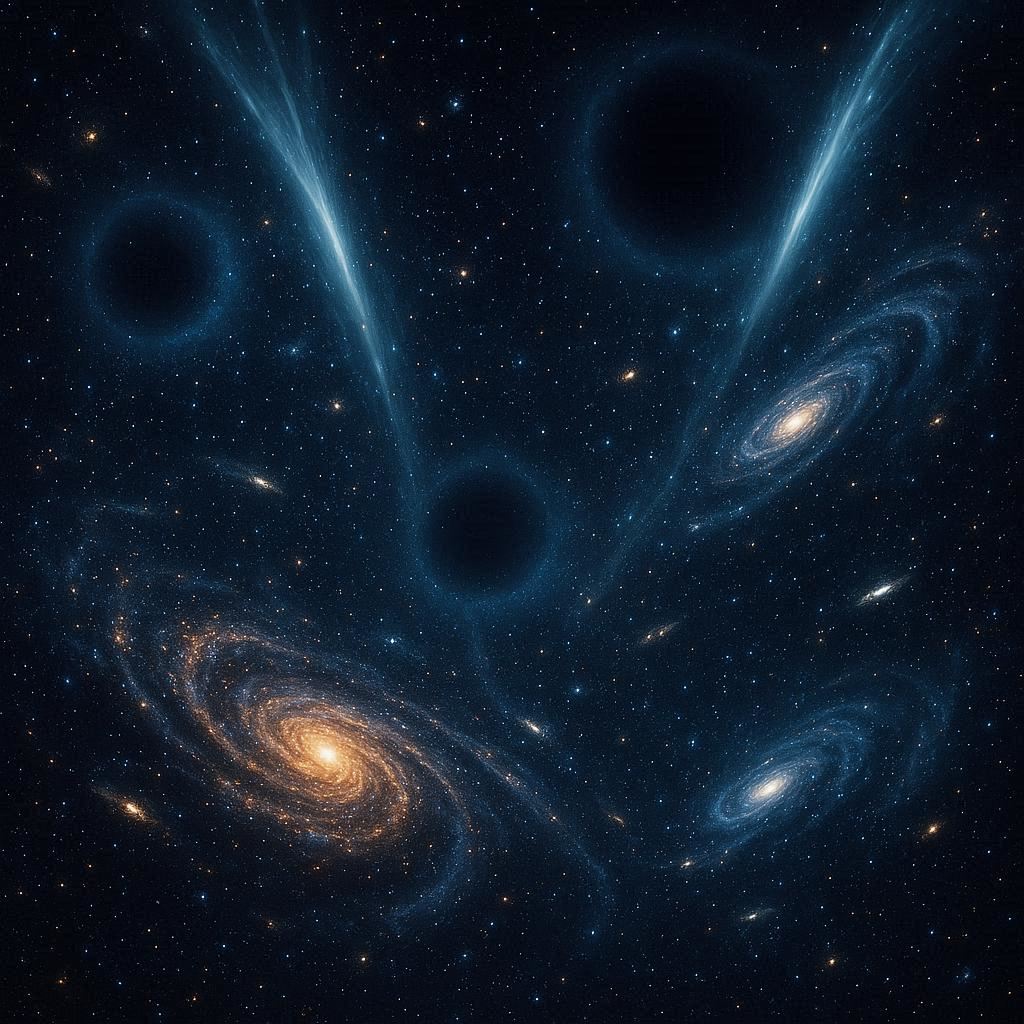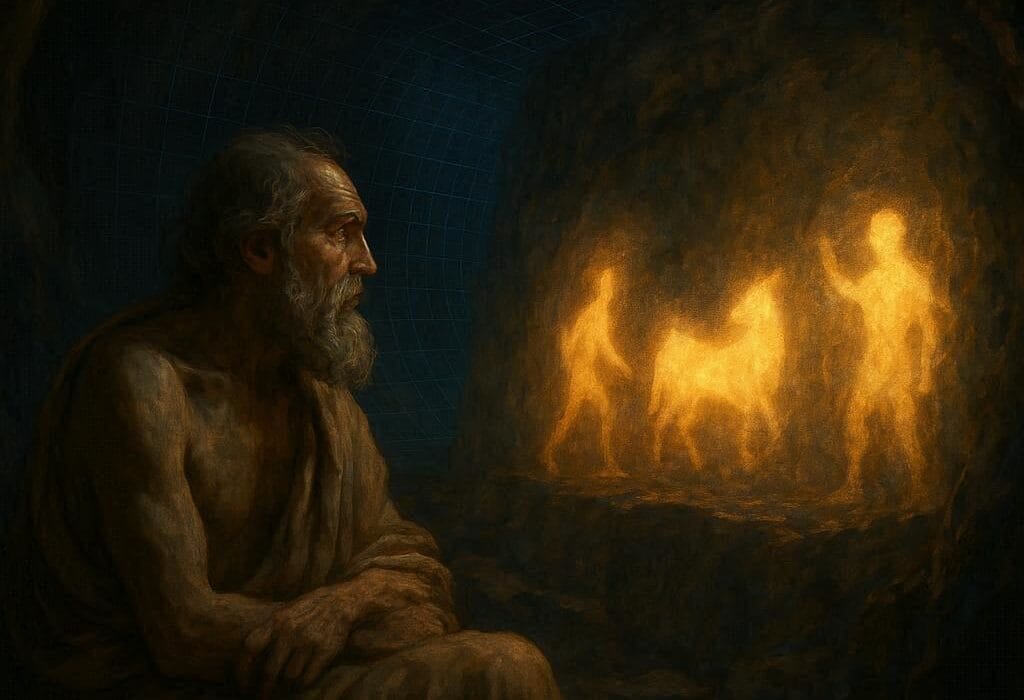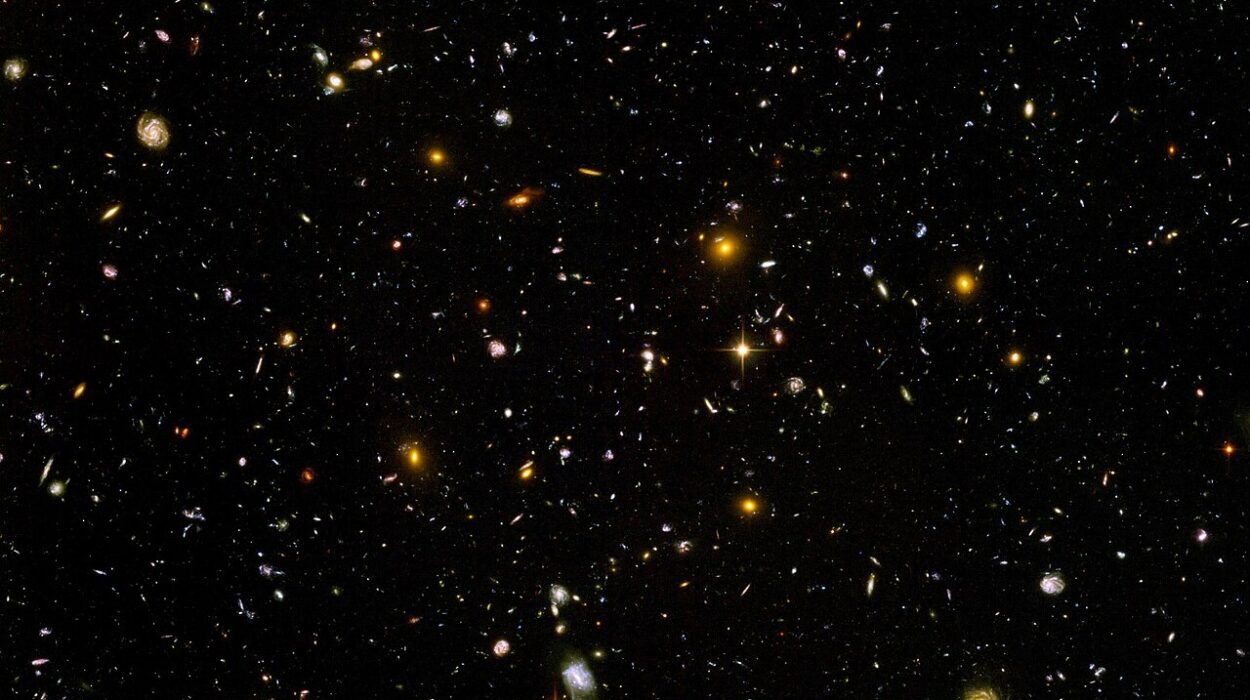Since the dawn of civilization, humans have looked to the heavens and sought to understand the fabric of reality. We have discovered planets, stars, galaxies, and the laws that govern them, from Newton’s mechanics to Einstein’s relativity. At the atomic and subatomic scale, we have unraveled the structure of matter into quarks, electrons, and neutrinos, and described forces that bind them with astonishing precision. Yet for all our achievements, the universe remains profoundly mysterious. Observations reveal that what we know—ordinary matter and energy—accounts for only a small fraction of the cosmos.
The familiar elements, the stars that shine, the planets we inhabit, and even interstellar gas clouds constitute merely about five percent of the universe’s total energy budget. The remaining ninety-five percent is hidden, manifesting itself only through gravitational effects or subtle cosmic imprints. This realization has forced physicists and astronomers to confront a radical possibility: there are forms of matter and energy in the universe that lie entirely beyond the reach of our current senses and instruments.
Dark Matter: The Invisible Backbone
Dark matter is perhaps the most compelling evidence that the universe harbors unknown forms of matter. First inferred in the 1930s by astronomer Fritz Zwicky, dark matter revealed itself in the motion of galaxies within clusters. Stars at the edges of galaxies moved as if pulled by far more mass than could be observed. Over decades, additional evidence accumulated, from gravitational lensing, which bends light around massive invisible structures, to the detailed mapping of the cosmic microwave background, the faint afterglow of the Big Bang.
Despite its profound influence on the cosmos, dark matter remains invisible. It does not emit, absorb, or reflect light, and it interacts so weakly with ordinary matter that trillions of dark matter particles pass through us every second without leaving a trace. Yet its gravitational pull shapes the formation of galaxies, clusters, and the large-scale web of cosmic structure. Without it, the universe as we see it would not exist.
Physicists have proposed numerous candidates for dark matter, from weakly interacting massive particles (WIMPs) to axions and sterile neutrinos. Each represents a form of matter beyond the Standard Model, the well-established framework that describes known particles and forces. Experiments deep underground, in particle accelerators, and even in the icy expanses of Antarctica are designed to detect these elusive particles, yet so far, they remain hidden, teasing scientists with the promise of discovery.
Dark Energy: The Force Accelerating the Cosmos
Even more enigmatic than dark matter is dark energy, a mysterious form of energy that permeates space and drives the accelerated expansion of the universe. In the late 1990s, observations of distant supernovae revealed that the cosmos was not slowing down under gravity’s pull, as once expected, but expanding ever faster. This discovery upended our understanding of cosmology and introduced a new player: a pervasive energy that exerts a repulsive gravitational effect.
Dark energy comprises roughly seventy percent of the universe’s total energy budget, dwarfing the contribution of stars, planets, and galaxies. Its nature is entirely unknown. Some theories suggest it is a property of space itself, a constant energy density that remains unchanged as the universe grows. Others propose dynamic fields that evolve over time, capable of influencing the fate of the cosmos. Theoretical physicists even speculate that dark energy may be a sign of deeper, higher-dimensional physics, hinting at realities far beyond our three-dimensional perception.
Exotic Matter and the Frontiers of Particle Physics
Beyond dark matter and dark energy, the realm of particle physics suggests other exotic forms of matter that could exist but have yet to be observed. The Standard Model describes a zoo of particles—quarks, leptons, bosons—that interact through well-characterized forces. Yet it is widely believed to be incomplete. Phenomena such as neutrino oscillations, the hierarchy problem, and the nature of gravity indicate that hidden sectors may exist, populated by particles that barely interact with the familiar universe.
Supersymmetry, a leading theoretical framework, proposes that every known particle has a heavier “superpartner.” These superparticles could provide dark matter candidates or reveal entirely new dynamics at energies beyond the reach of current accelerators. Similarly, string theory suggests that the fundamental constituents of matter are not point-like particles but vibrating strings, capable of producing a multitude of hidden dimensions and exotic energy states. In such a universe, the matter we know is only the tip of an immense iceberg.
Parallel Universes and Multiverse Theories
If hidden matter and energy exist, why might they remain undetectable? One radical possibility lies in the idea of multiple universes. Multiverse theories propose that our observable universe is just one bubble in a vast cosmic foam, each with its own laws of physics. Some of these universes could contain entirely different forms of matter and energy, imperceptible to us but influencing reality through subtle effects.
The notion of a multiverse emerges from several lines of reasoning. Inflationary cosmology, which describes the exponential expansion of the early universe, naturally predicts regions of space that stop inflating at different times, creating separate “pocket universes.” String theory’s landscape of solutions suggests an enormous number of stable configurations, each potentially giving rise to a unique universe with its own particle content. While these ideas are speculative, they hint at the possibility that matter and energy beyond our detection could exist not only locally, as in dark matter, but across inaccessible dimensions of reality.
Quantum Fields and Hidden Energies
At the subatomic level, quantum mechanics introduces even more opportunities for hidden matter and energy. The vacuum of space is not empty but filled with fluctuating quantum fields, where particles and antiparticles briefly pop into existence and annihilate in the blink of an eye. These vacuum fluctuations carry energy, some of which may contribute to the observed effects of dark energy.
Moreover, quantum field theory allows for the existence of particles that interact only through gravity or other weakly coupled forces. Known as sterile neutrinos or hidden photons, these particles could pervade the universe, contributing to its mass and influencing the evolution of cosmic structures without ever being directly observed. The boundary between “known” and “hidden” matter thus becomes a question of interaction rather than existence, highlighting how much of the universe may elude our senses simply because it communicates in unfamiliar ways.
The Role of Gravity in Unseen Matter
Gravity, the oldest known force, is also one of the most mysterious. While we understand its effects on planets, stars, and galaxies, its behavior at quantum scales remains elusive. The search for a quantum theory of gravity could reveal entirely new forms of matter and energy, perhaps composed of gravitons or other exotic quanta.
Hypothetical particles such as axions, initially proposed to solve problems in quantum chromodynamics, might interact primarily through gravity. Similarly, theories of extra dimensions suggest that gravity could leak into higher-dimensional space, giving rise to hidden sectors of matter and energy that remain invisible to conventional instruments. In this context, our universe may be a complex interplay of visible matter, hidden matter, and energies we cannot yet measure, all governed by underlying principles that we are only beginning to glimpse.
Cosmic Rays and Unseen Particles
High-energy cosmic rays provide tantalizing hints of unknown matter. These particles, traveling near the speed of light, collide with the Earth’s atmosphere in bursts of energy far beyond what human-made accelerators can achieve. Some experiments have detected anomalies—unexplained excesses of positrons or muons—that hint at interactions with dark matter or other exotic phenomena.
While these signals are not yet definitive, they demonstrate the potential of the universe itself as a laboratory for discovering hidden matter. By observing the cosmic environment, scientists may uncover forms of matter that evade detection in controlled experiments, revealing a richer and more intricate cosmos than previously imagined.
Philosophical Implications of Hidden Matter and Energy
The discovery of matter and energy beyond our perception has profound philosophical implications. It challenges the notion that humans can ever achieve a complete understanding of reality. If ninety-five percent of the universe is hidden, then what we see—the planets, stars, and galaxies—is a small fragment of a far larger truth. This realization is both humbling and exhilarating, suggesting that the cosmos is far more complex and wondrous than any model we have constructed.
Furthermore, hidden matter and energy raise questions about the nature of existence itself. Are these unseen forms of matter fundamentally different, or are they extensions of the familiar, obeying the same laws in ways we do not yet comprehend? Could consciousness itself be affected by dimensions of matter and energy that remain imperceptible, hinting at connections between the physical and the metaphysical? These questions blur the line between science and philosophy, inviting a profound reflection on the limits of knowledge.
The Future of Exploration
The quest to uncover hidden matter and energy is accelerating. New telescopes, both terrestrial and space-based, promise unprecedented views of the cosmos. Experiments such as the Large Hadron Collider continue to probe higher energies, searching for particles beyond the Standard Model. Underground detectors and neutrino observatories aim to capture fleeting interactions with dark matter. And theoretical work in quantum gravity, string theory, and cosmology pushes the boundaries of imagination, proposing worlds beyond our current reach.
In the coming decades, humanity may uncover forms of matter and energy that are as strange and beautiful as Einstein’s revelations about relativity. These discoveries could transform technology, reshape cosmology, and alter our understanding of existence itself. The universe, it seems, is an infinite canvas, with visible stars painting only a fraction of the picture, and hidden matter and energy filling the spaces in between with shadows and light.
Conclusion: The Cosmic Unknown
The universe we inhabit is at once familiar and profoundly mysterious. Ordinary matter, the kind we can see, touch, and manipulate, is a minority player in a cosmos dominated by hidden forces. Dark matter, dark energy, and exotic particles remind us that reality extends far beyond our senses and instruments. Quantum fields and cosmic anomalies hint at even more profound secrets, suggesting that the universe may be far richer than we dare imagine.
To confront the unknown is to embrace both humility and wonder. Humanity’s journey into hidden matter and energy is a testament to curiosity, persistence, and the capacity to dream beyond the visible. Every experiment, observation, and theory is a step toward understanding not just what exists, but what might exist beyond perception.
The universe whispers of unseen forces, of matter and energy that defy comprehension yet shape our cosmic destiny. The search is ongoing, the questions endless, and the implications staggering. In the end, the study of hidden matter and energy is more than a scientific pursuit—it is a reflection of our deepest desire to know the universe in all its hidden grandeur.
The cosmic stage is vast, and we are only beginning to glimpse the actors behind the curtain. Beyond what we see lies a universe alive with hidden possibilities, waiting to be discovered.






